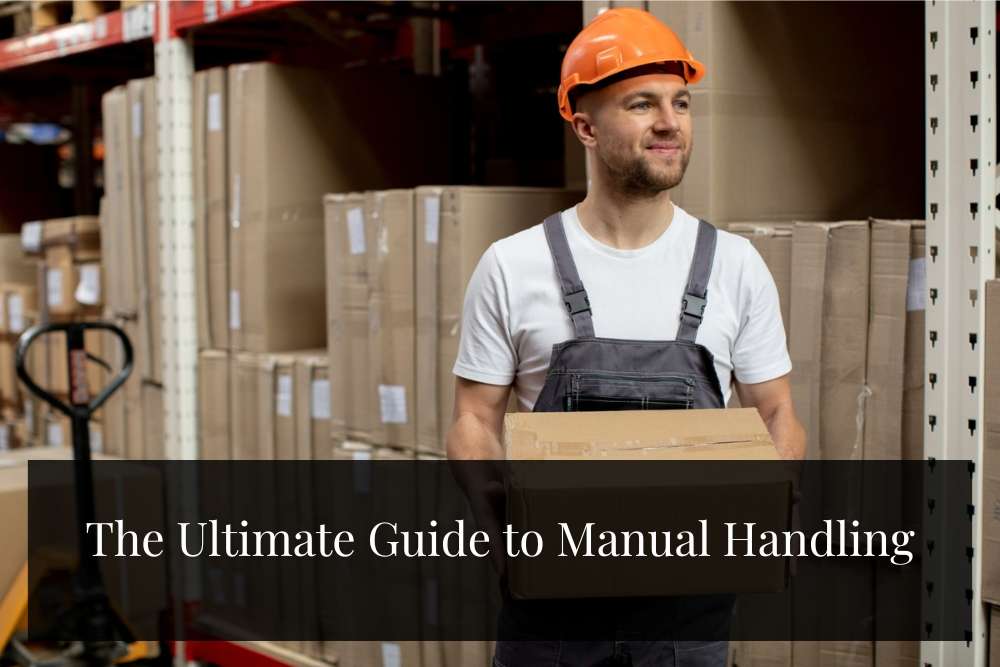Manual handling, an intrinsic part of many occupations, encompasses a wide range of activities involving the physical movement of objects or people. It involves actions such as lifting, pushing, pulling, carrying, or holding loads by hand or bodily exertion. These tasks require the engagement of muscles, tendons, ligaments, and joints to execute various manual handling maneuvers.
Ensuring safe manual handling practices is of paramount significance in occupational settings. By implementing proper techniques and protocols, employers and employees can mitigate the risks associated with manual handling tasks. Safe manual handling practices not only protect workers from injuries but also enhance overall workplace safety and productivity.
Efficient manual handling techniques, such as maintaining a neutral body posture, using appropriate lifting aids or equipment, and employing teamwork, contribute to the reduction of physical strain and fatigue. Workers who adhere to these practices are less likely to experience musculoskeletal disorders, thereby safeguarding their long-term health and well-being.
Understanding Manual Handling Risks and Hazards
A.Common Types of Manual Handling Tasks
Manual handling tasks encompass a diverse array of activities performed in various industries and workplaces. Understanding the common types of manual handling tasks provides insights into the potential risks and hazards associated with them.
Here are some examples:
- Lifting and Carrying: Lifting and carrying objects is a fundamental manual handling task encountered across industries. It involves exerting force to raise and transport items from one location to another, often placing strain on the back, shoulders, and arms.
- Pushing and Pulling: Pushing or pulling heavy loads, such as carts, trolleys, or machinery, requires substantial effort and can strain muscles and joints. Uneven or slippery surfaces further contribute to the risk of accidents and injuries during these tasks.
- Repetitive Tasks: Repetitive manual handling tasks, including assembly line work, packing, or sorting, involve performing the same motions repeatedly over an extended period. These tasks can lead to cumulative trauma disorders, such as tendonitis or carpal tunnel syndrome.
- Awkward Postures: Manual handling tasks that involve working in awkward postures, such as bending, twisting, or reaching, pose a heightened risk of musculoskeletal injuries. These tasks can strain the spine, neck, and other joints, increasing the likelihood of strains, sprains, or herniated discs.
B.Identifying Potential Risks and Hazards
To ensure safe manual handling practices, it is crucial to identify potential risks and hazards associated with specific tasks. Recognizing these factors enables employers and workers to implement appropriate control measures. Here are some key elements to consider when identifying manual handling risks and hazards:
- Load Characteristics: Assessing the weight, size, and stability of the load is essential. Bulky or unstable objects increase the risk of accidents and injuries during handling.
- Environmental Factors: Factors like limited space, uneven surfaces, or obstacles in the work area can impede safe manual handling. Identifying and mitigating these environmental hazards is crucial to prevent accidents.
- Frequency and Duration: Analyzing the frequency and duration of manual handling tasks helps gauge the cumulative impact on the body. Tasks performed repeatedly or for prolonged periods elevate the risk of overexertion and musculoskeletal disorders.
- Individual Factors: Considering individual factors, such as age, physical fitness, and prior injuries, helps tailor manual handling practices to the capabilities and limitations of each worker. Some individuals may require additional support or modifications to perform tasks safely.
Read more about what are the Risks associated with Manual Handling here.
C.Ergonomics and its Role in Manual Handling
Ergonomics, the science of designing tasks, equipment, and environments to fit the capabilities and limitations of individuals, plays a crucial role in promoting safe manual handling. Applying ergonomic principles helps reduce the risk of injuries and optimize efficiency. Here are key aspects of ergonomics in manual handling:
- Equipment and Tools: Using ergonomically designed equipment and tools can minimize the physical strain associated with manual handling tasks. Examples include lifting aids, adjustable workstations, and handles with proper grips.
- Workstation Design: Optimizing the design of workstations involves arranging tools, controls, and materials within easy reach, promoting proper posture, and allowing for adjustments to accommodate different body sizes and shapes.
- Training and Education: Providing comprehensive training and education on ergonomic practices ensures that workers understand the importance of correct techniques, posture, and body mechanics during manual handling tasks. This empowers them to make informed decisions and reduces the likelihood of injuries.
- Job Rotation and Breaks: Encouraging job rotation and incorporating regular breaks allows for rest and recovery, minimizing the risk of fatigue and overexertion during manual handling tasks.
By integrating ergonomics into manual handling practices, organizations can proactively mitigate the risks and hazards associated with such tasks. This proactive approach not only protects the health and well-being of workers but also enhances productivity and efficiency. Prioritizing ergonomic considerations in the design and implementation of manual handling processes creates a safer and more conducive work environment, where workers can perform their tasks with reduced physical strain and improved overall comfort.
Manual Handling Laws and Regulations
A.Overview of Workplace Safety Regulations
Workplace safety regulations form the legal framework that governs manual handling practices and sets standards to ensure the well-being of workers. These regulations vary across jurisdictions but generally aim to protect workers from hazards and promote a safe working environment.
Here is an overview of key aspects of workplace safety regulations related to manual handling:
- Occupational Safety and Health (OSH) Acts: Many countries have enacted OSH acts or similar legislation that outlines the rights and responsibilities of employers and employees regarding workplace safety. These acts often contain specific provisions addressing manual handling hazards and the measures to be taken to mitigate them.
- Risk Assessment Requirements: Workplace safety regulations typically require employers to conduct risk assessments to identify and evaluate hazards associated with manual handling tasks. This assessment helps determine appropriate control measures and safeguards to protect workers.
- Duty of Care: Workplace safety regulations impose a duty of care on employers to ensure the health and safety of their employees. This duty includes implementing measures to prevent manual handling injuries, providing training and education on safe practices, and maintaining a safe working environment.
B.Compliance with Manual Handling Laws
Compliance with manual handling laws is essential for both employers and employees to uphold workplace safety standards. Adhering to these laws helps mitigate the risks and hazards associated with manual handling tasks.
Key elements of compliance include:
- Training and Education: Employers must provide appropriate training and education to employees regarding safe manual handling practices. This includes instruction on correct lifting techniques, proper use of equipment and tools, and awareness of potential hazards. Regular refresher training may be necessary to reinforce these practices.
- Risk Control Measures: Employers should implement appropriate control measures based on the findings of risk assessments. These may include providing lifting aids, modifying workstations, or introducing automation to reduce manual handling tasks. Regular inspections and maintenance of equipment are crucial to ensure their effectiveness.
- Reporting and Incident Management: Compliance involves establishing mechanisms for reporting manual handling incidents, near misses, and hazards. Employers should investigate incidents promptly, identify contributing factors, and take corrective actions to prevent recurrence.
Read more about Compliance with Manual Handling Laws here.
C.Responsibilities of Employers and Employees
Workplace safety regulations outline the specific responsibilities of both employers and employees in ensuring safe manual handling practices. Clear delineation of responsibilities helps create a shared commitment to workplace safety.
Here are key responsibilities:
- Employers’ Responsibilities:
- Provide a safe working environment free from hazards related to manual handling tasks.
- Conduct risk assessments and implement appropriate control measures to minimize manual handling risks.
- Provide training, instruction, and supervision on safe manual handling practices.
- Maintain and regularly inspect equipment and tools used for manual handling tasks.
- Encourage open communication, reporting of incidents, and employee participation in safety initiatives.
- Provide a safe working environment free from hazards related to manual handling tasks.
- Employees’ Responsibilities:
- Follow safe manual handling practices and use provided equipment and tools correctly.
- Attend training sessions and actively engage in learning about proper techniques and hazards.
- Report any unsafe conditions, incidents, or near misses to supervisors or the appropriate authority.
- Cooperate with employers and follow established procedures for incident reporting and investigation.
- Take care of their own health and safety and that of their co-workers by adhering to safe practices.
- Follow safe manual handling practices and use provided equipment and tools correctly.
By fulfilling their respective responsibilities, employers and employees work together to create a culture of safety and compliance with manual handling laws. This collaboration fosters a workplace where the risk of injuries associated with manual handling tasks is minimized, promoting the overall well-being of the workforce.
Manual Handling Techniques and Best Practices
A.Correct Lifting Techniques for Different Objects
Mastering correct lifting techniques is essential to minimize the risk of injuries during manual handling tasks. The specific technique employed may vary depending on the characteristics of the object being lifted.
Here are some best practices for lifting different objects:
- Light Objects: For light objects, the most suitable technique is the one-handed lift. Stand close to the object, bend your knees, and grasp it securely with one hand. Maintain a neutral spine position and lift the object smoothly using leg muscles.
- Heavy Objects: When lifting heavy objects, it is crucial to use the squat lift technique. Position yourself close to the object, feet shoulder-width apart. Bend your knees, keep your back straight, and grasp the object firmly. Engage your leg muscles and lift the object by straightening your legs, maintaining a stable core.
- Bulky Objects: For bulky objects that are difficult to grasp, such as large boxes or furniture, it is advisable to use a team lift technique. Coordinate with a colleague and communicate effectively to ensure a synchronized lift. Lift the object together, using your leg muscles and maintaining proper body alignment.
Want to know more about Proven Strategies and Techniques for Safe Manual Handling? Read it here.
B.Body Mechanics and Posture during Manual Handling
Maintaining correct body mechanics and posture throughout manual handling tasks is crucial to minimize the risk of musculoskeletal injuries.
Consider the following best practices:
- Neutral Spine: Maintain a neutral spine position during lifting and carrying tasks. Avoid excessive bending, twisting, or leaning, as these movements can strain the back and increase the risk of injury. Keep your back straight and aligned with your hips.
- Core Activation: Engage your core muscles to provide stability and support during manual handling tasks. Strong core muscles help distribute the load effectively and reduce the strain on other body parts.
- Proper Footwear: Wear appropriate footwear with good traction and support to ensure stability and prevent slips or trips during manual handling. Choose shoes with cushioning and arch support to minimize the impact on your feet and lower limbs.
- Avoid Overreaching: When reaching for objects, avoid overextending your arms or leaning excessively. Instead, use step stools or appropriate reaching aids to access objects at higher levels. Maintain a balanced stance and avoid stretching beyond your limits.
C.Using Equipment and Assistive Devices Safely
The use of equipment and assistive devices can greatly enhance manual handling safety and efficiency.
Here are some best practices for their safe utilization:
- Familiarization and Training: Ensure that employees receive proper training on the correct operation and safe use of equipment and assistive devices. Familiarize yourself with the manufacturer’s instructions and guidelines before using any equipment.
- Maintenance and Inspection: Regularly inspect and maintain equipment to ensure its proper functioning and safety. Report any malfunctions, defects, or damage to supervisors immediately. Follow recommended maintenance schedules and procedures.
- Proper Adjustment and Fit: Adjust equipment and assistive devices to fit your body size and capabilities. Ensure that handles, straps, or grips are at an appropriate height and within comfortable reach. Poorly adjusted equipment can increase the risk of accidents or strains.
- Weight Limits and Capacity: Adhere to the weight limits and capacity specifications of equipment and assistive devices. Overloading equipment can compromise its stability and increase the risk of accidents and injuries.
- Communication and Coordination: When using equipment or assistive devices in a team setting, effective communication and coordination are essential. Establish clear signals and ensure that all team members are synchronized in their actions to prevent accidents or mishaps.
By employing correct lifting techniques, maintaining proper body mechanics and posture, and utilizing equipment and assistive devices safely, workers can significantly reduce the risk of manual handling injuries. It is crucial to promote a culture of safety, provide regular training and reinforcement of these best practices, and encourage open communication among employees to ensure ongoing adherence to safe manual handling techniques.
Manual Handling Training and Education
Implementing comprehensive training programs on manual handling is essential to ensure the safety and well-being of employees. Such training programs provide employees with the knowledge, skills, and awareness necessary to perform manual handling tasks correctly and safely.
Here are key reasons highlighting the importance of training programs:
- Injury Prevention: Training programs equip employees with the necessary techniques and knowledge to prevent injuries during manual handling tasks. By understanding the risks, proper body mechanics, and safe lifting techniques, employees can significantly reduce the occurrence of musculoskeletal injuries.
- Awareness of Hazards: Training programs raise awareness about the hazards associated with manual handling tasks. Employees learn to recognize potential risks, such as heavy loads, awkward postures, or slippery surfaces, and understand how to mitigate these hazards to maintain a safe working environment.
- Compliance with Regulations: Training programs ensure that employees are aware of and comply with relevant regulations and guidelines related to manual handling. This includes understanding their rights and responsibilities, reporting procedures for incidents and hazards, and complying with ergonomic and safety standards.
- Improved Efficiency: Proper training enhances the efficiency and productivity of manual handling tasks. Employees learn techniques to optimize their movements, use equipment effectively, and work in coordination with others. This leads to reduced fatigue, improved work methods, and increased efficiency in completing manual handling tasks.
Looking for an Online Manual Handling Certification Course? Then you are in the right place. You can Enroll from here.
A.Designing Effective Manual Handling Training Modules
To ensure the effectiveness of manual handling training programs, it is crucial to design modules that address the specific needs of employees and the tasks they perform.
Here are some key considerations for designing effective training modules:
- Task-Specific Approach: Tailor training modules to address the specific manual handling tasks encountered in the workplace. Identify common tasks, hazards, and challenges employees face and design training content accordingly.
- Interactive Learning: Incorporate interactive learning methods, such as hands-on exercises, simulations, case studies, and group discussions, to actively engage employees in the learning process. This promotes better retention of knowledge and encourages the application of safe practices in real-world situations.
- Practical Relevance: Emphasize the practical relevance of the training content by relating it directly to employees’ work responsibilities. Use real-life examples, demonstrations, and scenarios that resonate with their day-to-day experiences.
- Clear Communication: Ensure that training modules use clear and concise language that is easily understood by all employees. Avoid jargon and technical terms unless necessary, and provide explanations and definitions where needed.
- Continuous Learning: Consider incorporating refresher training sessions or ongoing learning opportunities to reinforce safe manual handling practices. This helps employees retain knowledge, adapt to new techniques, and stay updated with any changes in regulations or best practices.
B.Training Techniques and Practical Demonstrations
To enhance the effectiveness of manual handling training, it is essential to employ a variety of training techniques and practical demonstrations.
Here are some techniques to consider:
- Visual Demonstrations: Utilize videos, animations, or illustrations to visually demonstrate correct manual handling techniques. Visual representations help employees understand the proper body mechanics, lifting techniques, and the use of equipment.
- Role-Playing: Engage employees in role-playing exercises that simulate real-life manual handling scenarios. This allows them to practice safe techniques, decision-making, and communication skills in a controlled environment.
- Practical Exercises: Provide opportunities for hands-on practice to reinforce learning. Set up mock workstations or use props to simulate manual handling tasks, allowing employees to practice proper techniques and receive immediate feedback.
- Peer Learning: Encourage employees to share their experiences, challenges, and best practices related to manual handling. Peer learning creates a collaborative learning environment where employees can learn from one another’s experiences and exchange ideas.
- Case Studies and Group Discussions: Use case studies or group discussions to analyze real-life manual handling incidents or scenarios. This encourages critical thinking, problem-solving, and the application of learned techniques to practical situations. Employees can discuss alternative approaches, identify potential hazards, and develop strategies for safe manual handling.
- Feedback and Evaluation: Provide regular feedback and evaluations to assess employees’ understanding and proficiency in manual handling techniques. This helps identify areas that may require further training or reinforcement and ensures ongoing improvement.
By incorporating a combination of training techniques, practical demonstrations, and interactive learning methods, manual handling training programs become more engaging, effective, and memorable for employees. This empowers them to apply safe practices, make informed decisions, and contribute to a safer and healthier work environment.
C.Statistics on Manual Handling Injuries
Grappling with manual handling injuries remains a pressing concern across various industries. Alarming statistics emphasize the urgency of implementing preventive measures to curb these incidents and protect workers.
Here are a few compelling figures that shed light on the prevalence and impact of manual handling injuries:
- Global Burden: According to the International Labour Organization (ILO), manual handling injuries account for a significant portion of work-related disabilities worldwide, constituting a major contributor to lost work time and economic costs.
- Musculoskeletal Disorders: The Bureau of Labor Statistics (BLS) reports that musculoskeletal disorders, often attributed to poor manual handling practices, accounted for a substantial proportion of occupational illnesses in several countries. These disorders encompass a range of conditions affecting muscles, tendons, ligaments, and other soft tissues.
- Lost Workdays: The National Institute for Occupational Safety and Health (NIOSH) estimates that manual handling injuries result in millions of lost workdays annually. These absences not only impact individual workers but also disrupt organizational productivity and strain the economy.
- Healthcare Sector Impact: In the healthcare sector, manual handling injuries pose a significant concern. Nurses and other healthcare workers are particularly susceptible due to the demanding nature of their roles, involving frequent patient lifting and transferring. Data from healthcare organizations worldwide underscores the prevalence of manual handling injuries within this sector.
- Economic Consequences: Manual handling injuries impose substantial economic burdens on individuals, employers, and society at large. The costs associated with medical treatment, rehabilitation, lost wages, and disability compensation highlight the financial implications of inadequate manual handling practices.
These statistics serve as a clarion call for prioritizing safe manual handling practices and investing in preventive measures to alleviate the burden of injuries associated with manual tasks. By raising awareness, providing training, and implementing ergonomic solutions, organizations can foster a safer working environment that protects the well-being of their workforce.
Preventing Manual Handling Injuries
A.Risk Assessment and Hazard Control Measures
Preventing manual handling injuries begins with conducting thorough risk assessments and implementing appropriate hazard control measures. By identifying potential risks and hazards associated with manual handling tasks, organizations can proactively mitigate them.
Here are key steps to consider:
- Risk Assessment: Perform comprehensive risk assessments to identify potential hazards, assess the likelihood and severity of injuries, and evaluate the effectiveness of existing control measures. This involves analyzing factors such as load characteristics, environmental conditions, and individual capabilities.
- Hazard Control: Implement control measures to eliminate or minimize identified hazards. This may include engineering controls, such as using lifting aids or adjusting workstations, administrative controls like implementing proper work procedures and job rotation, and personal protective equipment (PPE) when necessary.
- Training and Education: Provide employees with comprehensive training and education on safe manual handling practices. This includes raising awareness of hazards, teaching proper lifting techniques, promoting ergonomic principles, and emphasizing the importance of reporting incidents and near misses.
- Regular Reviews: Conduct periodic reviews of risk assessments and control measures to ensure their ongoing effectiveness. This allows for adjustments and improvements based on changing circumstances, such as new tasks, equipment, or organizational changes.
B.Creating a Safe and Ergonomic Work Environment
Creating a safe and ergonomic work environment is crucial in preventing manual handling injuries. By optimizing workplace design and implementing ergonomic solutions, organizations can significantly reduce the risk of injuries.

Consider the following strategies:
- Workstation Design: Ensure workstations are designed ergonomically, taking into account factors such as proper heights, clear pathways, and adequate space for maneuvering. This includes arranging tools, equipment, and materials within easy reach to minimize awkward postures and excessive reaching.
- Mechanical Aids and Equipment: Provide appropriate mechanical aids and equipment to assist with manual handling tasks. This may include using lifting devices, conveyors, adjustable height workbenches, or powered tools to reduce the physical demands on workers.
- Environmental Factors: Create a clean and well-maintained work environment, free from potential slip, trip, or fall hazards. Minimize obstacles, ensure proper lighting, and address issues such as temperature and humidity to promote a safe and comfortable workplace.
- Ergonomic Training and Assessments: Train employees on ergonomic principles and educate them about proper body mechanics, posture, and positioning. Encourage self-assessment and provide opportunities for employees to provide feedback on ergonomic concerns and suggestions for improvement.
C.Strategies for Injury Prevention and Management
In addition to risk assessment and creating a safe work environment, implementing strategies for injury prevention and management further strengthens the prevention of manual handling injuries.
Here are some key strategies to consider:
- Encourage Stretching and Warm-up: Promote the importance of stretching and warm-up exercises before engaging in manual handling tasks. These activities help prepare muscles and joints, reduce the risk of strains, and improve flexibility.
- Job Rotation and Breaks: Implement job rotation and regular breaks to minimize prolonged exposure to manual handling tasks. This allows for recovery periods and reduces the risk of fatigue, which can contribute to injuries.
- Reporting and Incident Investigation: Establish a culture of reporting incidents, near misses, and hazards related to manual handling. Encourage open communication and investigate incidents promptly to identify root causes and implement corrective measures.
- Early Intervention and Rehabilitation: Implement early intervention programs to address any signs of discomfort, pain, or early symptoms of musculoskeletal disorders. Provide access to rehabilitation services and support employees in their recovery to prevent further progression of injuries.
- Ongoing Monitoring and Evaluation: Continuously monitor the effectiveness of injury prevention strategies, evaluate their impact, and make necessary adjustments. Regularly review injury data, incident reports, and employee feedback to identify trends and areas for improvement.
By implementing these preventive strategies, organizations can significantly reduce the occurrence of manual handling injuries. It is essential to foster a culture of safety, where employees are empowered to actively participate in injury prevention efforts, communicate hazards, and contribute to the continuous improvement of manual handling practices. With a holistic approach that encompasses risk assessment, ergonomic considerations, and injury prevention strategies, organizations can create safer and healthier work environments for their employees.
Manual Handling in Specific Industries
A.Manual Handling in Healthcare and Nursing
Manual handling is an integral part of daily operations in the healthcare and nursing sectors, where workers frequently engage in patient handling and moving heavy medical equipment. The unique demands of this industry necessitate specific considerations for safe manual handling practices.
Here are key aspects:
- Patient Handling: Healthcare workers, particularly nurses, regularly engage in tasks such as lifting and transferring patients. Specialized techniques, including using lifting aids, proper body mechanics, and teamwork, are essential to minimize the risk of injuries to both the patient and the healthcare worker.
- Ergonomic Solutions: Healthcare facilities should provide ergonomic equipment, such as patient lifts, adjustable beds, and transfer aids, to facilitate safe patient handling. Training programs should focus on proper utilization of these devices and emphasize the importance of maintaining a safe and ergonomic work environment.
- Training and Education: Comprehensive training programs are crucial for healthcare workers to acquire the skills and knowledge required for safe patient handling. Topics covered should include techniques for transferring patients, managing mobility aids, and strategies to prevent musculoskeletal injuries specific to the healthcare environment.
B.Manual Handling in Construction and Manufacturing
The construction and manufacturing industries involve various manual handling tasks, ranging from lifting heavy materials to operating machinery. Due to the nature of the work, the risk of manual handling injuries is significant.
Here are key considerations for promoting safety in these industries:
- Machinery and Equipment Operation: Construction and manufacturing workers often use machinery and equipment that requires manual handling. Proper training on equipment operation, including safe startup, shutdown, and maintenance procedures, is vital to minimize the risk of accidents and injuries.
- Material Handling: These industries involve the movement of heavy and bulky materials. The use of mechanical aids, such as forklifts, cranes, or conveyors, should be encouraged whenever feasible. Training programs should emphasize safe lifting techniques, utilization of appropriate personal protective equipment (PPE), and recognizing potential hazards associated with different materials.
- Workplace Design and Organization: Designing workstations and organizing the workspace to minimize the need for excessive manual handling can reduce the risk of injuries. This includes proper storage and labeling of materials, clear pathways, and ergonomic considerations in the design of workstations and tools.
C.Manual Handling in Retail and Warehousing
Manual handling tasks are prevalent in the retail and warehousing sectors, where workers frequently handle and transport goods. The fast-paced nature of these industries poses unique challenges.
Consider the following aspects for promoting safe manual handling practices:
- Proper Lifting Techniques: Training programs should focus on teaching employees correct lifting techniques, including using the legs, maintaining a neutral spine, and avoiding overexertion. Employees should also be encouraged to request assistance or use equipment, such as trolleys or carts, for moving heavy or bulky items.
- Organizational Systems: Implementing efficient organizational systems, such as proper product placement, clear signage, and well-designed storage areas, can reduce the need for excessive manual handling and minimize the risk of accidents and injuries. Regular reviews and adjustments to these systems help maintain their effectiveness.
- Teamwork and Communication: Encouraging teamwork and effective communication among retail and warehouse workers is crucial. This includes coordinating with colleagues to lift heavy objects, providing clear instructions when working in groups, and reporting potential hazards or safety concerns promptly.
- Training on Manual Handling Equipment: Retail and warehousing workers often utilize manual handling equipment, such as pallet jacks or hand trucks. Comprehensive training programs should cover the safe use of these tools, including proper handling, maintenance, and awareness of potential risks associated with their operation.
By addressing industry-specific challenges and implementing tailored strategies, manual handling practices can be made safer in healthcare, construction, manufacturing, retail, and warehousing. Organizations should prioritize ongoing training, provide necessary equipment, and foster a culture of safety to ensure the well-being of workers in these industries. Additionally, regular assessments of manual handling tasks, continuous improvement initiatives, and open communication channels are vital to adapting and implementing effective measures to prevent manual handling injuries.
Ergonomic Solutions for Manual Handling
A.Introduction to Ergonomics in Manual Handling
Ergonomics plays a crucial role in promoting safe and efficient manual handling practices. It involves designing tasks, equipment, and work environments to fit the capabilities and limitations of individuals, thus reducing the risk of injuries and optimizing performance. When applied to manual handling, ergonomic solutions focus on minimizing physical strain, improving body mechanics, and enhancing overall comfort.
Here are key aspects to consider:
- Biomechanics: Ergonomics in manual handling takes into account the biomechanical principles of the human body, including proper alignment of joints, balanced muscle exertion, and reduced stress on ligaments and tendons. By understanding these principles, ergonomic solutions can be tailored to mitigate the risk of musculoskeletal injuries.
- Individual Variability: Ergonomics recognizes that individuals have different physical capabilities, including strength, reach, and flexibility. Designing solutions that accommodate these individual differences helps ensure that manual handling tasks can be performed safely and comfortably by all workers.
B.Ergonomic Equipment and Tools for Safe Handling
Utilizing ergonomic equipment and tools is essential for promoting safe manual handling practices. These specialized devices are designed to minimize physical strain and provide support during lifting, carrying, and other manual handling tasks.
Here are some examples of ergonomic equipment and tools:
- Lifting Aids: Devices such as hoists, slings, or patient lifts are used to assist in lifting heavy loads or transferring individuals, reducing the physical effort required by workers. These aids provide mechanical advantage and ensure safe and controlled movement.
- Handling Gloves: Ergonomic gloves with specialized grip patterns or padding can enhance grip strength, improve dexterity, and reduce the risk of slippage during manual handling tasks. These gloves offer comfort, protection, and increased safety when handling objects.
- Ergonomic Handles: Tools and equipment designed with ergonomic handles, such as hand tools with cushioned grips or handles with contours that fit the hand’s natural shape, reduce hand fatigue, improve grip stability, and minimize the risk of strain or injuries.
- Anti-Fatigue Mats: Anti-fatigue mats provide cushioning and support to reduce the strain on workers’ feet, legs, and lower back during prolonged standing tasks. These mats enhance comfort and help alleviate the impact of static postures on the body.
C.Integrating Ergonomics into Workstation Design
Designing workstations with ergonomic considerations can significantly contribute to safe and efficient manual handling practices. By optimizing the physical layout, arrangement of tools, and work processes, ergonomic workstation design minimizes physical strain, reduces the risk of injuries, and improves productivity.
Consider the following aspects:
- Height-adjustable Workstations: Providing height-adjustable workstations allows workers to customize the height of the work surface, ensuring that tasks can be performed comfortably and at appropriate ergonomic levels. This helps reduce awkward postures and excessive reaching.
- Proper Lighting: Adequate lighting in workstations is essential to ensure visibility and minimize eye strain. Properly positioned and adjustable lighting fixtures help reduce glare and shadows, enhancing overall visibility and promoting a safer working environment.
- Storage and Organization: Well-designed storage systems and easy access to frequently used tools and materials minimize the need for excessive reaching, bending, or twisting during manual handling tasks. Proper organization reduces the risk of strain and ensures efficient workflow.
- Ergonomic Seating: For tasks that involve prolonged sitting, ergonomic seating solutions, such as chairs with adjustable height, lumbar support, and comfortable padding, promote proper posture, reduce the risk of back pain, and enhance overall comfort during manual handling activities.
Integrating ergonomic solutions into manual handling practices demonstrates a commitment to worker safety, health, and well-being. By prioritizing ergonomic considerations, organizations can significantly reduce the risk of musculoskeletal injuries, improve worker comfort, and enhance overall productivity. Regular assessments, feedback from employees, and continuous improvement initiatives are vital for optimizing ergonomic solutions and ensuring their ongoing effectiveness. Implementing these solutions promotes a positive work environment where manual handling tasks can be performed safely, efficiently, and with reduced physical strain.
Manual Handling and Workplace Safety Culture
A.Promoting a Culture of Safety and Awareness
Promoting a culture of safety and awareness is paramount in preventing manual handling injuries and creating a safe work environment. It involves instilling a collective commitment to prioritize safety, fostering open communication, and encouraging active participation in safety initiatives.
Here are key aspects to consider:
- Leadership and Management Commitment: Leadership plays a crucial role in setting the tone for workplace safety. Management should actively demonstrate their commitment to safety through policies, resource allocation, and leading by example. This commitment promotes a safety-conscious culture throughout the organization.
- Employee Engagement: Engage employees in safety initiatives by involving them in decision-making processes, soliciting their feedback, and recognizing their contributions to safety improvements. Empowered employees are more likely to take ownership of their own safety and the safety of their colleagues.
- Continuous Education and Training: Provide ongoing education and training on manual handling practices, hazard identification, and incident reporting. Regularly reinforce safe practices, share success stories, and communicate updates on regulations or best practices to keep employees informed and engaged.
B.Communication and Reporting of Manual Handling Issues
Effective communication and reporting mechanisms are crucial for identifying and addressing manual handling issues promptly. Open lines of communication ensure that potential hazards, incidents, and near misses are reported and acted upon, facilitating proactive risk mitigation.
Consider the following approaches:
- Encouraging Reporting: Create an environment where employees feel comfortable reporting manual handling issues, including hazards, incidents, or near misses, without fear of retribution. Emphasize the importance of reporting as a means to improve safety and prevent future incidents.
- Anonymous Reporting: Offer anonymous reporting channels, such as suggestion boxes or online reporting systems, to encourage employees to report concerns without revealing their identity. This promotes honest and transparent reporting, allowing organizations to identify and address systemic issues.
- Incident Investigation and Follow-up: Thoroughly investigate reported incidents and near misses related to manual handling. Identify root causes, implement corrective actions, and communicate the outcomes to employees. Follow-up on implemented measures to ensure their effectiveness and address any lingering concerns.
C.Collaboration between Employees and Management
A collaborative approach between employees and management fosters a strong safety culture and enhances manual handling practices. It encourages teamwork, shared responsibility, and joint problem-solving.
Consider the following strategies for collaboration:
- Safety Committees and Representatives: Establish safety committees or appoint safety representatives consisting of employees from different departments or work areas. These committees/representatives can facilitate communication, gather feedback, and actively contribute to safety improvement initiatives.
- Joint Risk Assessments: Involve employees in the risk assessment process by seeking their input and insights. Their firsthand knowledge and experience can provide valuable insights into potential hazards and help identify effective control measures.
- Feedback Mechanisms: Encourage employees to provide feedback on manual handling procedures, equipment, and work processes. Actively seek their suggestions for improvement and involve them in the evaluation and selection of ergonomic equipment or tools. This collaboration fosters a sense of ownership and enhances the relevance and effectiveness of implemented solutions.
- Recognition and Rewards: Recognize and reward employees for their active involvement in safety initiatives and their contributions to promoting safe manual handling practices. This reinforces the importance of safety, motivates continued engagement, and reinforces the value placed on employees’ well-being.
By fostering a culture of safety, promoting effective communication, and encouraging collaboration between employees and management, organizations can create a workplace where manual handling safety is ingrained in daily operations. This collective effort enhances awareness, facilitates timely reporting and resolution of issues, and drives continuous improvement in manual handling practices.

Conclusion
Manual handling is a common task in various industries and workplaces, and its proper execution is essential for the safety and well-being of workers. This article has provided a comprehensive overview of manual handling, emphasizing the importance of safe practices, risk assessment, and ergonomic considerations. By implementing the strategies and best practices outlined in this guide, organizations can significantly reduce the risk of manual handling injuries and create a culture of safety.
Through proper training and education, employees can gain the knowledge and skills necessary to perform manual handling tasks correctly. Understanding correct lifting techniques, maintaining proper body mechanics, and utilizing ergonomic equipment is crucial for minimizing the physical strain associated with manual handling. Furthermore, compliance with manual handling laws and regulations ensures that workplaces adhere to safety standards and protect workers’ rights.
Frequently Asked Questions (FAQs)
Manual handling refers to the process of lifting, carrying, pushing, or pulling objects or people by hand. It involves the use of physical effort and can be found in various industries and workplaces.
Safe manual handling is important to prevent injuries and musculoskeletal disorders. It helps minimize the risk of strains, sprains, and other physical injuries that can result from improper lifting techniques or overexertion.
Common manual handling hazards include heavy loads, awkward postures, repetitive movements, inadequate training, slippery surfaces, and inadequate space or lighting. Identifying and addressing these hazards is crucial for maintaining a safe working environment.
Ergonomics plays a significant role in manual handling by focusing on designing tasks, equipment, and work environments that fit the capabilities and limitations of individuals. It aims to reduce physical strain, improve body mechanics, and enhance overall comfort and safety during manual handling tasks.
Employers can promote safe manual handling practices by providing comprehensive training programs, conducting regular risk assessments, providing ergonomic equipment and tools, fostering a culture of safety, and encouraging open communication between employees and management. These measures help create a safe work environment and minimize the risk of injuries.
Manual handling risks include lifting heavy objects, repetitive movements, awkward postures, and inadequate training. These risks can lead to musculoskeletal injuries, strains, and sprains if not properly addressed and mitigated.
Some common manual handling risks include heavy lifting, improper body mechanics, inadequate training, repetitive tasks, and working in awkward postures. These risks can result in injuries such as strains, sprains, and musculoskeletal disorders if preventive measures are not taken.
Handling risks in manual handling can be achieved through several approaches. These include conducting risk assessments, implementing control measures, providing proper training and education, utilizing ergonomic equipment, promoting a culture of safety, and regularly reviewing and improving safety practices.
Physical risks refer to potential dangers that can arise from manual handling tasks. These risks include strains, sprains, overexertion, falls, collisions, and exposure to harmful substances. Addressing these physical risks is crucial to ensure the safety and well-being of workers during manual handling activities.
The five types of hazards include physical hazards (such as noise or vibration), chemical hazards (such as exposure to toxic substances), biological hazards (such as pathogens), ergonomic hazards (such as improper lifting techniques), and psychosocial hazards (such as stress or workplace violence). Identifying and managing these hazards is essential for maintaining a safe working environment.













